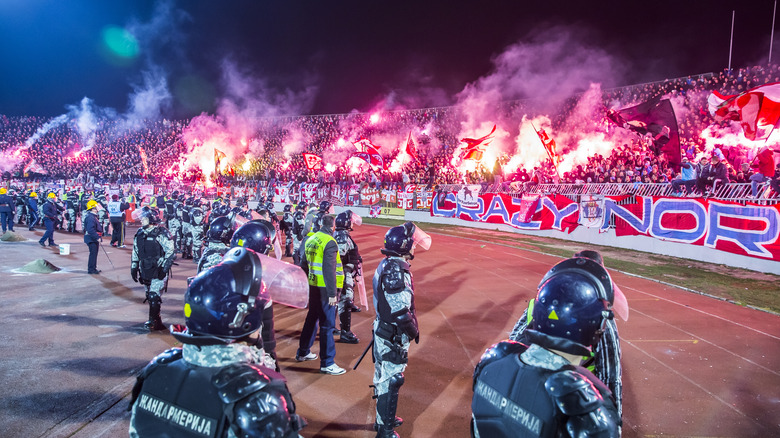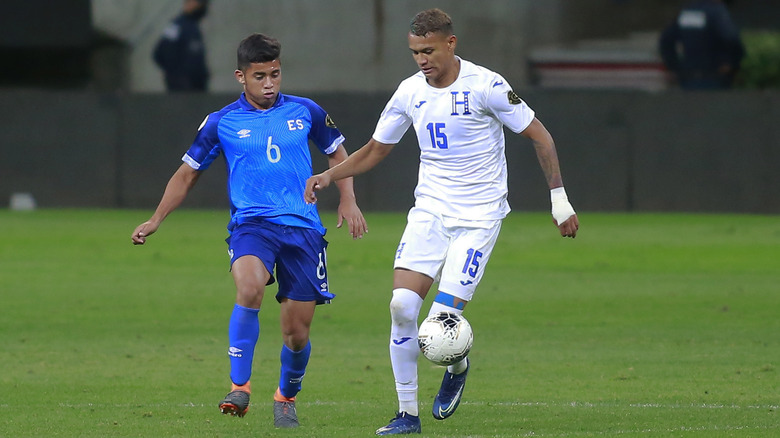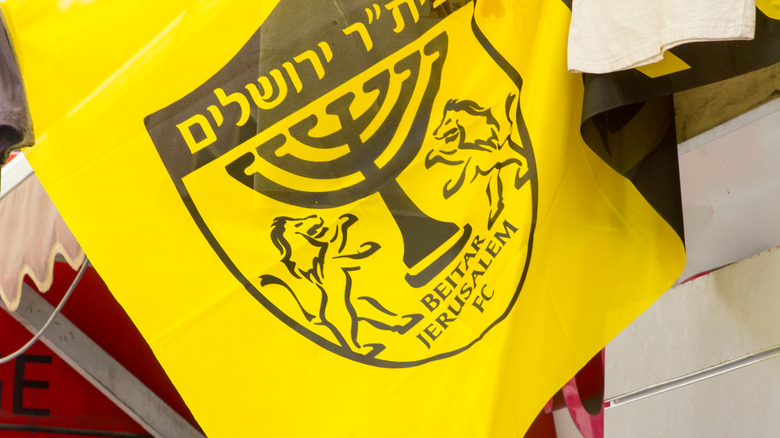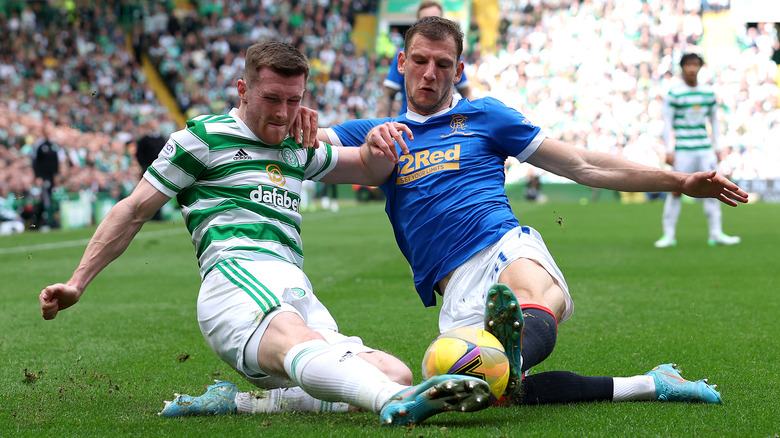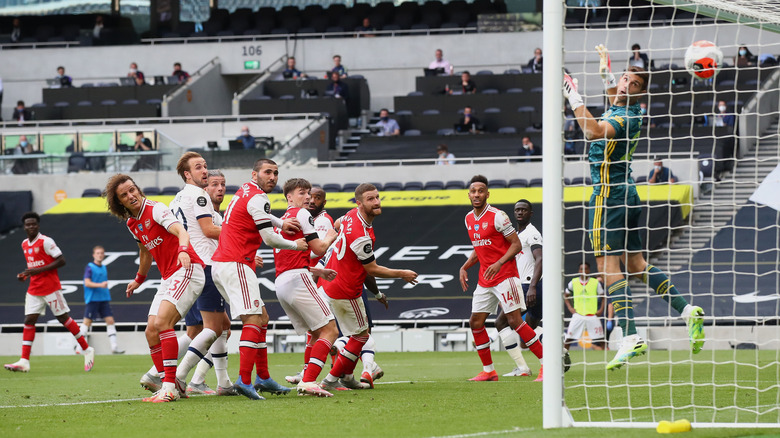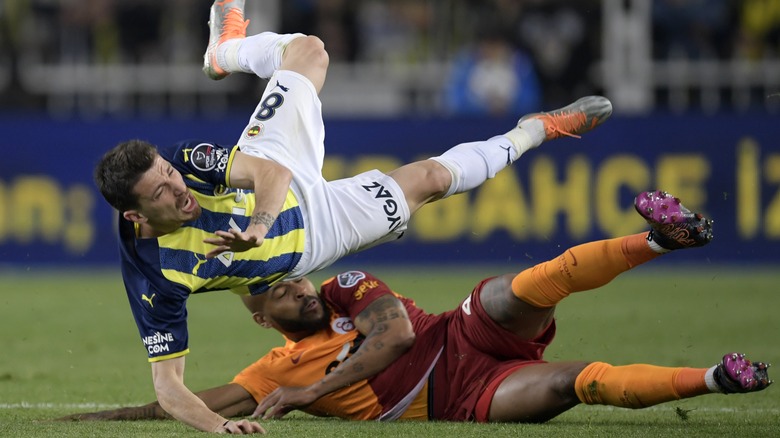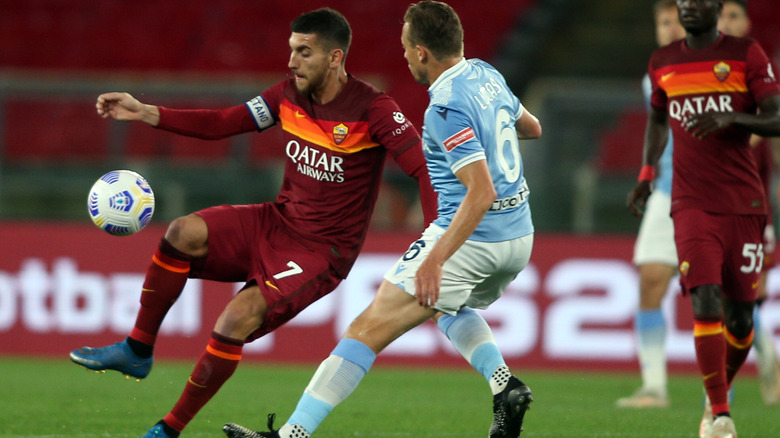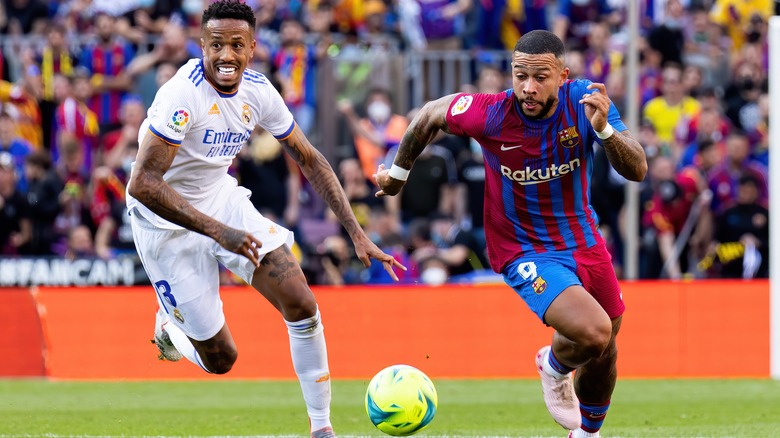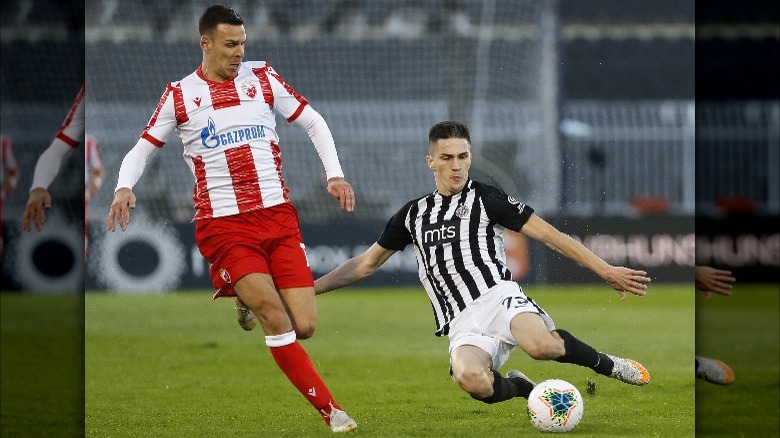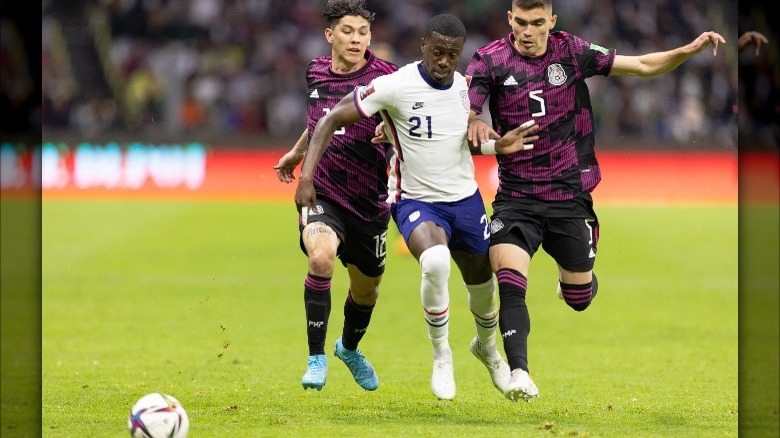Professional Soccer's Biggest, Wildest Rivalries
Soccer, or the "beautiful game" as fans call it, is by far the world's most popular sport. It is also the one that incites the most passion, both at the club level and the national level. Soccer rivalries, often pitting a country's strongest teams or teams from the same city against each other, are filled with adoring fans, colorful banners, fireworks, and, of course, violence.
Soccer rivalries are often about more than just the game. Obviously, city or country pride is at stake, but often there are politics involved too. Different groups of ultras (diehard supporters) frequently have opposing political affiliations and sympathies that lead to fights and deaths. On at least one occasion, such rivalries have ignited wars. Today, at least among the major rivalries, things have become less heated, and violence has decreased. But that does not mean that the rivalries are any less fierce. Here are some of the most famous and crazy international soccer rivalries.
Dinamo Zagreb - Red Star Belgrade
Dinamo Zagreb and Red Star Belgrade are no longer rivals. The former plays in Croatia and the latter in Serbia. But according to EuroNews, these two sides were regular table-toppers and rivals in the old Yugoslav first division. Their rivalry became increasingly visible amid Yugoslav political unrest.
According to Trans World Sport, the two sides' 1990 meeting in Zagreb took place in a climate of political instability. Numerous Yugoslav political agitators from Serbia and Croatia alike, especially the members of Dinamo's Bad Blue Boys and Red Star's Delije attended. According to popular lore, they managed to start a war.
Dinamo fans claimed that the Delije (allegedly) began attacking families while police stood by. So Dinamo's Bad Blue Boys attacked the Red Star fans, and a massive riot involving acid-throwing ensued. The mostly-Serb police attacked the Dinamo fans, so Dinamo captain Zvonimir Boban kicked one of them from behind, much to the delight of the home fans. Boban got a six-month ban from Yugoslav soccer but became a hero in Croatia.
According to the Real Football Factories documentary, fans from both sides would soon be shooting at each other on Yugoslavia's bloody battlefields during the Croatian War of Independence. Dinamo fans see themselves as the men that started the war with the riot and Boban's famous kick, which is memorialized on a monument in Zagreb.
Serbia - Bosnia
With the wounds of the Bosnian War still open, Serbia & Montenegro and Bosnia met in 2005 for one of the last two European places in the 2006 World Cup. According to a BBC Frontline documentary, this meeting occurred under less-than-ideal circumstances. Memories of the Bosnian War, which had ended a mere eight years earlier, were still fresh, making the match a potential disaster in the making.
At the game, Bosnian security forces in full riot gear (a typical occurrence at Bosnian sporting events then) fortified the stadium and kept the two groups of fans completely separate. Nationalist flags -– including those of Turkey and Albania -– were banned, but there was no hiding the hate. Bosnian ultras called for Serbs to be hung from trees while Serbian fans sang anti-Bosniak wartime songs during the game. That game ended in a 1-1 draw, so everything rested on the return leg in Belgrade.
In the return leg, Serbia & Montenegro won 1-0 (via ESPN) with Mateja Kezman's goal at the 5-minute mark. Kezman appeared to flash the three-finger salute of Serbian nationalism in celebration. Kezman, if he did do it, was probably in part thumbing his nose at the furious Bosnian fans.
Honduras - El Salvador
According to Duke University, Honduras and El Salvador experienced a period of tense relations in the 1960s, particularly as illegal immigration from El Salvador to Honduras caused resentment in the latter country. When Salvadorans began illegally occupying unclaimed Honduran land, the tensions escalated despite attempts by both governments to solve cross-border issues. It also started a soccer rivalry.
1969 also happened to be a World Cup qualifying year for the 1970 edition held in Mexico. At the end of CONCACAF qualifying, Honduras and El Salvador were tied on points. To break the deadlock, a playoff took place in neutral Mexico City, which El Salvador won 3-2.
Although the qualifier was not the cause of the war, both governments used it to fuel jingoistic nationalism. The Honduran government commenced deportations of Salvadoran immigrants. According to Sports Illustrated, El Salvador's elite, however, had no interest in seeing their poorer countrymen return to crowded lands and pressured the government to declare war on Honduras. Meanwhile, the unpopular Honduran government used Salvadoran immigration as a distraction from its own failings. The game was just another place for each side to voice its feelings about the other.
El Salvador eventually launched an air raid against Honduran territory. Although the OAS managed to negotiate a peaceful end, up to 3,000 non-combatants perished. The rivalry between these two countries on the field still exists. Fortunately, though, as Last Word on Sports notes, it is peaceful –- thanks in no small part to improved relations between the two countries.
Beitar Jerusalem - Bnei Sakhnin
Israel's most frequent association is with the never-ending conflict over the disputed Palestinian territories. This conflict is played out on the field, too, as demonstrated in the fierce and often violent rivalry between Bnei Sakhnin and Beitar Jerusalem.
Hailing from a mixed Muslim-Christian town, Bnei Sakhnin, per Prospect Magazine, is Israel's Arab team. Per The Guardian, they are considered proof that coexistence between Israel's Arabs and Jews is possible -– and this is reflected in the club's history. When it won the Israeli Cup in 2004, it had a Jewish coach and Jewish players. Beitar Jerusalem's hardcore supporters (aka La Familia), however, the Financial Times notes, consist mostly of nationalist-minded Sephardi Jews that were expelled from Arab countries in 1948. In a Guardian documentary, they proudly referred to themselves as "forever pure" (aka no Arab players) and as the "most racist team in Israel." So when Beitar recruited two Chechen players, one of whom was accused of using his Beitar shirt –- which features a menorah -– as a prayer mat, offended fans tried to burn down the club offices (via TRT).
Crowd trouble is common at this volatile fixture. According to The Times of Israel, when Beitar defeated Sakhnin on the road, Sakhnin fans attacked Beitar fans and the police with stones, leading to six arrests. When Sakhnin drubbed Beitar 3-0 a year later, Beitar fans fired rockets at Sakhnin players, resulting in 15 arrests (via The Times of Israel). The players have taken part too in fights such as this one. However, things might change now that Beitar has an Emirati Arab owner.
Old Firm (Celtic - Rangers)
According to soccer finance website Transfermarkt, Celtic and Rangers have won every Scottish Premier League edition since 1986. But the two sides showcase Glasgow –- and Northern Ireland's -– sectarian divides that have often led to violence. According to Bleacher Report, the rivalry stems from religion. Celtic fans are Catholic Scottish nationalists, while Rangers fans are British Protestants. The game features songs glorifying violence, such as (via Daily Record) the banned song "Billy Boys," whose lyrics include "we're up to our knees in [expletive] blood," "[expletive]," and chants glorifying IRA terrorism in Northern Ireland.
The story of Mo Johnston illustrates the rivalry. According to the Herald Scotland, Rangers signed ex-Celtic Catholic star Mo Johnston in 1989. Scottish institutions and fans either praised Rangers' stand against sectarianism or decried Rangers' break with its tradition of not employing Catholics as a "sad day for Rangers." Celtic fans, meanwhile, were furious that their former great had signed with crosstown rivals. Rangers fans threatened to boycott their team. In the end, however, the boycotts did not materialize because Johnston scored 31 times in 76 appearances for the Rangers, who learned to overlook his past loyalties if he won them games.
While the Johnston saga ended well, violence has been an unfortunate feature of Old Firm games. The worst incident occurred in 1999 when, according to the Scottish Daily Record, a Celtic fan was shot in the chest with a crossbow. Lately, UEFA and the Scottish FA, per Bleacher Report, have taken steps to crack down on sectarian displays on both teams through fines and fan bans.
The North London Derby (Arsenal - Tottenham)
Tottenham and Arsenal dominate the North London sporting scene, putting on thrilling spectacles such as this 4-4 draw from 2015. Both teams, according to Goal, have been in the top flight of English soccer since 1979, and Arsenal has never been relegated -– or promoted. This fact ignited the North London rivalry in 1919 when corruption and conspiracy put Arsenal in the top flight at Tottenham's expense.
As Bleacher Report notes, Arsenal went bankrupt in 1910, so Tory politician Henry Norris bought the club and moved it to North London -– right down the street from Tottenham. Arsenal played in England's Division Two and Tottenham in Division One. After World War I, league reorganization allowed Arsenal into Division One without kicking a ball.
Norris conspired with Liverpool boss John McKenna, who also happened to be the league president, to vote Arsenal into the first division. Tottenham was in second-to-last place in Division One. So the teams voted to kick Tottenham out of the top flight in Arsenal's favor. Thus, a team that had finished sixth, behind more deserving teams, was sent to the top flight by politics rather than skill.
This rivalry is also relevant to Jewish history. 1930s Tottenham historically enjoyed a large Jewish fanbase, per the Jewish Chronicle. Arsenal fans mocked Tottenham supporters with anti-Semitic slurs, so fans started wearing Yarmulkes to games, incorporating the Star of David into Tottenham banners, and appropriating the slurs as terms of endearment. Although international Jewish groups and Tottenham itself (via CNN) have criticized their uses, Tottenham's own fans have continued to use them.
Kıtalararası Derbi (Fenerbahce and Galatasaray)
Turkey's two top teams have divergent class-based histories. Galatasaray, according to 90min, represented the Ottoman and later Turkish elite, beginning in one of Turkey's most elite high schools on the European side of the city. According to the documentary The International Football Factories, Fenerbahce historically represented Istanbul's working class and the army from the Asian side of the Bosphorus. Today, these boundaries have dissolved, but the fixture is still known for its massive banners, passionate fans, and violence from die-hard supporters.
Since the first fan riot in 1934, incidents at this fixture are legion. One Fenerbahce ultra admitted to hitting a close friend and Galatasaray supporter in the face with a flare during the game. In 2012, the BBC reported that following Galatasaray's Turkish title win, Fenerbahce's fans rioted. On the Galatasaray side, an off-duty police officer was stabbed for wearing a Fenerbahce shirt on the European side of the city and, at the 2007 derby, attacked police and ripped apart the stands after their side went 2-0 down.
So what causes such strong feelings to boil over? According to filmmaker Paul Okan (via IFF), Turkish soccer fanaticism in part comes from the country's economic conditions. Large sections of the population live in sub-par economic conditions. Soccer violence (especially when combined with alcohol) provides an emotional release against the police and an escape from reality for 90 minutes. Since ultras tend to come from lower-income strata, it is likely that their violence -– particularly against police -– has a political element.
Il Derby della Capital (Roma - Lazio)
Il Derby della Capitale pits Roman clubs AS Roma and SS Lazio against each other in what Bleacher Report refers to as "a warzone" and one of the most dangerous fixtures of the Serie A calendar. The rivalry rests on a few points. First, the two sides share the same stadium. Second, one disputes the other's right to exist in a feud that goes back to Italy's Facist era.
According to Slate, SS Lazio was founded as a military club that attracted common people with right-wing sympathies alongside middle- and upper-class conservatives that opposed communism and socialism during the early 20th century. The club competed against three others, but in 1927, Benito Mussolini, hoping to create a single club to represent Rome, ordered three of them to merge to form AS Roma. Lazio, however, which counted among its fans many prominent fascists, refused to join the merger and was allowed to remain independent. Mussolini later became a fan of the team.
AS Roma's fans, per The Guardian, were traditionally left-leaning or outright communist, putting them on a collision course with their cross-town rivals. Both teams historically are title contenders, so, unsurprisingly, riots and violence are common. Furthermore, Lazio fans are known for anti-Semitism, calling Roma fans "Jews" and deriding the Holocaust. More recently, politics have not figured as strongly given that Roma's fans have moved rightward as well. But they may reappear given that, according to DW, Mussolini's great-grandson Romano Floriani will be playing for Lazio as a midfielder.
El Clásico (Real Madrid - FC Barcelona)
The Barcelona-Real Madrid derby is known as El Clásico and is probably the best-known soccer rivalry in the world. But the derby in Spain itself has often been a byword for Spanish politics. Real Madrid is the team of Spain's capital elite. According to Goal, King Alfonso XIII bestowed royal patronage upon the team in 1920, making them the "royal team." But when the Spanish Republic came to power in 1931, the club found a new patron in the form of Spanish dictator Francisco Franco, who was himself a big fan. Barcelona, meanwhile, is Catalonia's team. As Goal notes, the team is closely tied to Catalan nationalism, which has spilled into open demands for independence. The blue, red, and gold flag is frequently seen at the games, and the club's working language is Catalan –- not Spanish.
Under the Franco regime, regional nationalism –- including in Catalonia –- was suppressed. The Catalan flag and language were banned, and Barcelona was forced to remove the flag from its crest. Franco also had one of Barcelona's presidents –- who was also a separatist left-wing politician, executed in 1936. So Barcelona became a refuge for Catalan nationalism and still is today. This rivalry came to a head in 1943 when Real defeated Barcelona 11-1 amid allegations that Franco's Falangistas had threatened Barcelona's players to lose the match.
Today, the rivalry is just as fierce, although its most violent days are behind us. But fans still celebrate humiliating the other side, such as this 5-0 defeat of Real Madrid Barcelona achieved in 2014.
Red Star Belgrade - Partisan
According to a Copa90 documentary, Serbia's biggest rivalry was established in Belgrade following World War II. Partizan was the army club, while Red Star was the people's club. They had been rivals since then and heightened in the 1990s, the rivalry is today feared as the most violent in the world. But is it deserved?
According to Sportco, the fixture gained its reputation in the 90s. As Yugoslavia broke up, fans found soccer as a means of nationalistic expression, which unsurprisingly spilled into violence. Politicians co-opted hooligans as political enforcers. Infamous Serb commander Zeljko "Arkan" Raznatovic was recruited among the Red Star Delije. These mini-militias unsurprisingly fought against the fans of other clubs and soon against other Yugoslav nationalities such as Croatia and Bosnia.
In the Copa90 documentary, many interviewees argued that the derby's negative image is outdated. Violence does occur, but it involves small groups of ultras that often have other agendas than the game. Instead of focusing on the passion of nonviolent fans, their love for their teams, and their colorful displays, western media highlighted the violence.
As the Copa90 documentary shows, violence has decreased since the peak years of the 90s and early 2000s, when as the Real Football Factories recorded, riots occurred every time the two teams played. But it still happens, the most recent example being a fight in March of 2022 (via Fox Sports) that left 50 people injured.
USA - Mexico
Ending on a brighter note, this cross-border rivalry dates back to 1934. According to Bleacher Report, the two teams first met in 1934, when the United States defeated Mexico to qualify for the 1934 edition of the World Cup in Italy. But since soccer was a very, very marginal sport at the time –- and would remain so until the 1990s –- the rivalry was one-sided. As US Soccer notes, Mexico was often CONCACAF's representative at the World Cup.
Things began to change in the 1990s. The United States qualified for the 1990 World Cup in Italy. Mexico didn't, and with the sport gaining increasing attention in the United States, the rivalry became real. Since then, the US and Mexico have played numerous times. Most notably, the United States knocked Mexico out of the 2002 World Cup Round of 16. In 2012, the United States won another small victory, beating Mexico in the legendary Estadio Azteca, albeit in a friendly manner (via CBS Sports). Mexico most famously humiliated the US with a 5-0 win in the 2009 Gold Cup final.
Unlike other rivalries, the US-Mexico matchup is tame. New York Post noted that occasionally individual Mexican fans have lobbed projectiles at American players and staff -– including bags of urine. Today, however, the rivalry is based on "mutual respect" but is no less intense. As American goalkeeper Tim Howard told USA Today, American players are judged on their performances against Mexico, and it doesn't look good to slip up against El Tri.
